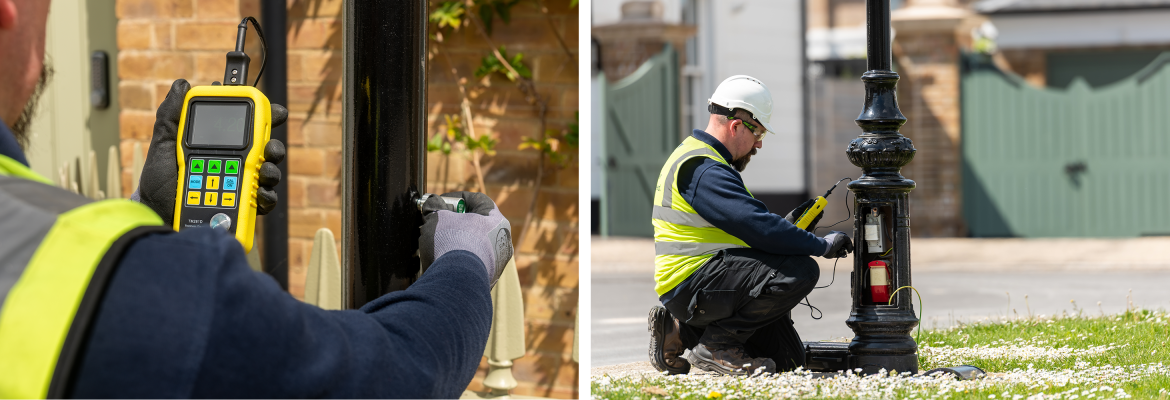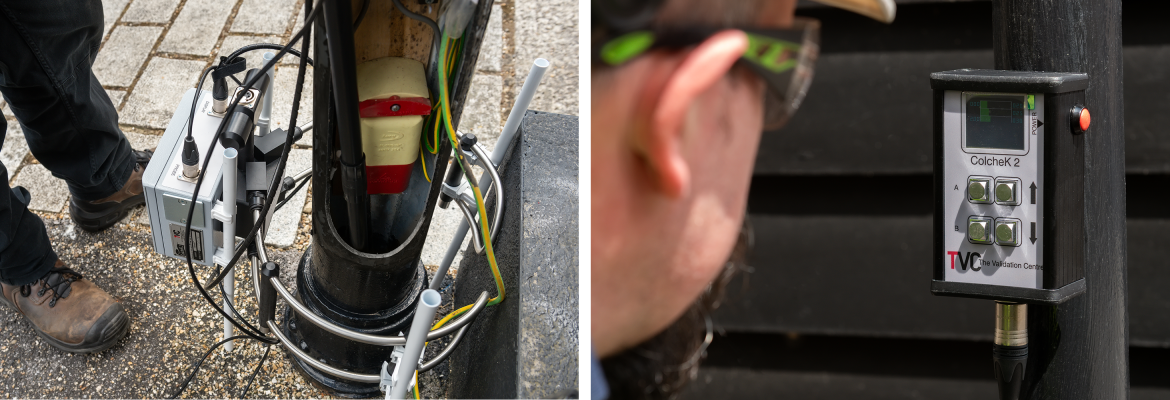Why regular testing is essential for lighting columns
July 2025
DW Windsor operates internationally. For the best experience in your region, please select the region most applicable to you.
July 2025
OPINION
Lighting columns are an essential and ubiquitous part of the urban landscape, but they must be maintained effectively to ensure they are safe, comply with regulations, and have a maximised lifespan. Electrical and structural column testing has an important role to play in this process, as Gavin Eeles, Project Manager, Structural & Quality at DW Windsor, explains.
There are around 6.5 million publicly owned lighting columns in the UK, with a vast number of other columns on private land such as in car parks, private roads and across university campuses. Where the condition of these assets is not monitored carefully over time, they can present a serious hazard to the public. There have sadly been cases where failures have caused columns to collapse, resulting in life-changing injury to people nearby.
While there is no specific legislation regarding the maintenance of lighting columns, local authorities, businesses and other organisations do have a responsibility to ensure the safety of any such assets in areas under their control. In the event of an incident, they may be asked to explain their approach and reasoning to ensure it was adequate. However, there are legal obligations to ensure safety included in legislation such as The Highways Act 1980 and The Health and Safety at Work etc Act 1974. Therefore, it is always recommended that those responsible for lighting assets ensure they have a strategy in place to understand the condition of the assets and carry out the appropriate maintenance.

The Institution of Lighting Professionals’ Guidance Note 22 (GN22) ‘Asset-Management Toolkit: Minor Structures’, which covers supports of luminaires, signage, signals and other electronic equipment, advocates a risk-based approach to asset management. This method prioritises maintenance, repairs and replacement based on the risk of failure. A risk-based, rather than prescriptive approach, is important as the condition and degradation of individual assets will be influenced by a wide range of factors, including age, location, exposure to the elements and the risk of physical damage. For example, columns on street corners are more likely to be damaged by vehicles and often experience increased corrosion from salt spray.
The role of testing
To achieve this risk-based approach, asset owners must have sufficient, up-to-date information on the condition of each asset. This asset management data should include asset and installation details, such as materials, dimensions and attachments; external influences; environmental conditions, such as wind exposure; and any previous treatment or repairs carried out.
Inspections and non-destructive testing of the columns have an important role to play in this. When conducted regularly by a qualified professional, this testing will provide a picture of the condition of the assets and degradation over time to inform the maintenance strategy. Regular testing can also help to optimise the lifespan of lighting columns. By identifying issues before they escalate, steps can be taken to address the problem and extend the life of the asset.
Effective column testing should include a number of structural and electrical tests to determine the current condition of the assets and any immediate causes for concern. While some types of lighting column will not allow certain types of testing, the best practice approach is to find a supplier who can provide all the tests described below.

Structural tests
Visual inspection: As the name suggests, this is a visual examination of the asset to identify external damage, wear, and corrosion. Photos should be taken as part of this process to provide a record of the condition and a reference for future inspections.
Eddy current test: Detects subsurface defects and corrosion in rooted steel columns by using a sensor placed inside the column. This typically assesses the integrity up to 400 mm below ground and 200 mm above ground to identify corrosion or material loss. Generally, this test cannot be carried out on cast iron columns as the non-uniform thickness of the casting produces unreliable results.
Ultrasonic test: Uses high-frequency sound waves to measure column thickness, detect internal flaws, and assess the condition of welds.
Crack test: Identifies surface and sub-surface cracks in welds and joints, to assess the structural strength, especially in critical areas such as the shoulder section of the column.
Electrical tests
Visual inspection: A visual assessment of the electrical components to check for visible damage, burning or shorts in the system to ensure safe and compliant operation.
Continuity test: This test verifies the integrity of the circuit by calculating resistance to ensure electrical safety and the correct performance.
Polarity test: Checks the wiring connections and verifies that live, neutral, and earth conductors are properly installed to prevent faults and hazards.
Loop test: Ensures that the column’s circuit protection devices perform correctly in the event of a fault to prevent injury and damage to the installation.
It is important that those responsible for lighting columns choose the right testing service provider. Testing should only be carried out by a competent person who has the correct training, knowledge and experience. In particular, it is important to ensure that the selected partner organisation has Highway Electrical Registration Scheme (HERS) certification.
Frequency of testing
In line with the risk-based approach, the required frequency of this testing is also determined by factors such as age, location-based risk and the findings of previous testing. For example, new installations will not need to be tested as frequently while columns approaching or beyond their expected lifespan should be tested on a more regular basis.
Depending on these factors, the testing strategy may require every column to be tested in a specified area. Alternatively, a visual inspection may be conducted on each asset, with more detailed testing carried out on a rotating proportion of the total in an area at each interval. Electrical testing should be carried out every six years and the interval between structural tests can be anything between six months and six years depending on the calculated level of risk.
Choosing a testing partner
It is important that those responsible for lighting columns choose the right testing service provider. Testing should only be carried out by a competent person who has the correct training, knowledge and experience. In particular, it is important to ensure that the selected partner organisation has Highway Electrical Registration Scheme (HERS) certification. This shows compliance with the National Highway Sector Scheme 8 (NHSS8), which requires employees of the organisation to be assessed against strict standards to demonstrate their competence.
For example, at DW Windsor we have a team of qualified engineers who use the latest technology to carry out a full suite of both electrical and structural testing on steel, aluminium, cast iron and kitted columns. With more than 45 years of experience in external lighting, we can work with local authorities and businesses to offer guidance on best practice asset maintenance.